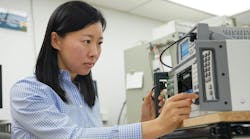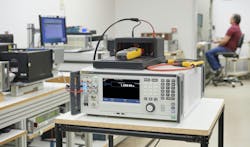6 Ways Innovation is Changing Calibration
What you’ll learn:
- How innovation is reshaping calibration.
- Six new technologies that are helping technicians overcome challenges.
Advances in the calibration industry are opening doors for professionals to achieve and maintain precision in new ways (see figure). These innovations directly address challenges faced by technicians identified in a Fluke Calibration survey, such as meeting demand for better performance, dealing with outdated equipment, and needing to calibrate machines faster.
Here, we’ll explore six new technologies paving the way to a more efficient, precise, and future-ready calibration industry.
1. Automated Software for Improved Process Accuracy and Efficiency
Calibration automation software can be used to convert manual processes and procedures into low-touch or even no-touch tasks. This improves calibration time as automation speeds up tasks that are time-consuming if performed manually.
In additon, automation frees up technicians from manual tasks to focus on more strategic and complex assignments that require their skills and expertise. Incorporating this software into your calibration laboratory can lead to a significant boost in calibration throughput, with the potential to increase efficiency by up to 200%.
Automating calibration tasks guarantees consistent execution every time, regardless of location or operator. This leads to improved repeatability. And it allows less-experienced technicians to be guided through procedures, freeing up your subject-matter experts to use their time where needed without risking a drop in quality.
2. Artificial Intelligence for Deep Learning and Intelligent Calibration
There’s no denying that we’re in a new era of artificial-intelligence (AI) technology. New applications of these tools are being identified daily, and calibration is one of many sectors benefitting from this technology boom.
Calibration systems driven by AI dynamically adapt and optimize processes using machine learning and advanced algorithms. These systems scrutinize vast datasets, accounting for variables like instrument behavior and environmental conditions to identify patterns and trends. This can aid processes like calibration interval optimization to improve reliability and reduce maintenance costs.
The automotive industry is already taking steps to use AI in design and development. As manufacturers come up with innovative solutions to challenges, such as trying to accelerate the electronic-control-unit (ECU) calibration process for hybrid and electric vehicles, AI is increasingly driving the process.
3. Cloud-Based Management Systems Establish Compliance Through Accessibility
Compliance is too critical to rely on outdated techniques. If there's anything that can motivate businesses to move beyond digitized databases and static spreadsheets, it’s a cloud-based management system—and for good reason.
Cloud-based systems will store all of your data and documentation in one centralized platform. They’re accessible from virtually anywhere, on multiple devices. This makes it simple and quick to pull up the required documentation in real-time during an audit to demonstrate compliance.
Furthermore, these systems enhance calibration processes by providing real-time visibility into instrument status, calibration schedules, and historical data. Constant access to data facilitates efficient monitoring and lends a hand when technicians need to make maintenance decisions.
Embracing the cloud also provides opportunities for further applications of AI and machine learning tools. Cloud-based access helps these programs leverage large amounts of data that can be anonymized and analyzed to learn more about measurement devices than ever before.
4. Another Step Toward Industry 4.0 with Digital Calibration Certificates
The advent of the digital calibration certificate (DCC) may soon make conventional calibration certificates obsolete.
A DCC isn’t merely a scanned copy of a traditional paper-based certificate, such as a PDF. Rather, it provides all calibration information in an extensible markup language (XML) format, which is machine-readable. This means that the information contained in a DCC can be transferred immediately to digitally supported processes. Cryptographic signatures are used to verify the authenticity of these certificates.
A DCC’s machine readability is particularly advantageous for production and quality monitoring processes. As manual creation and consolidation of data is eliminated, it reduces errors in data transfer and calculations. In addition, the automation facilitated by DCCs streamlines the production process, ensuring that all parts meet specifications outlined in the DCC. Overall, this innovation has great potential to enhance product quality and reliability.
5. New Temperature Sensor Technology Cuts Calibration Time in Half
Regulatory agencies like the FDA require pharmaceutical and biosciences industries to routinely calibrate their temperature sensors. To comply with regulation, most plants schedule calibration every six months.
But sometimes sensors can drift out of alignment in between calibrations, leading to ruined fermentation batches that can cause huge company losses. Fortunately, new technology has now made it possible for sensors to calibrate themselves at the end of each batch, ensuring continuous accuracy in temperature measurements. This frequent adjustment significantly reduces the risk of fermentation batch failures and associated financial losses.
Manually calibrating sensors requires disconnecting and reconnecting the system’s wiring, which is time-consuming and prone to errors. This is another way new advances help make the process more efficient. A technician can now twist the top of a sensor to remove it instead of disconnecting wires, which cuts calibration time in half.
6. Efficiency and Monitoring Through Remote or Touchless Calibration
Touchless calibration denotes the remote transfer of standard reference data from calibration laboratories to the customer’s facilities. The main objective is to provide real-time synchronized communication during the calibration process. This innovation collates information parameters from the calibration reference standard and shares them in real-time through a dedicated digital network.
While touchless calibration systems are still at a nascent stage, a 2022 study validated their ability to calibrate DC voltage. Today, touchless calibration is now being used in the shipping industry to monitor the conditions of perishables during transit. As this technology continues to evolve, its future applications in various industries hold promise for widespread adoption.
Demand for Precision Calibration on the Rise
Increased investment in calibration and the integration of advanced technologies significantly expands the possibilities. It’s no surprise that the global calibration services market is expected to witness a compound annual growth rate of around 5.6% from 2024 to the early 2030s.
This projected growth underscores the rising importance of precise calibration in diverse sectors, driving the demand for cutting-edge solutions and contributing to the market’s upward trajectory.

